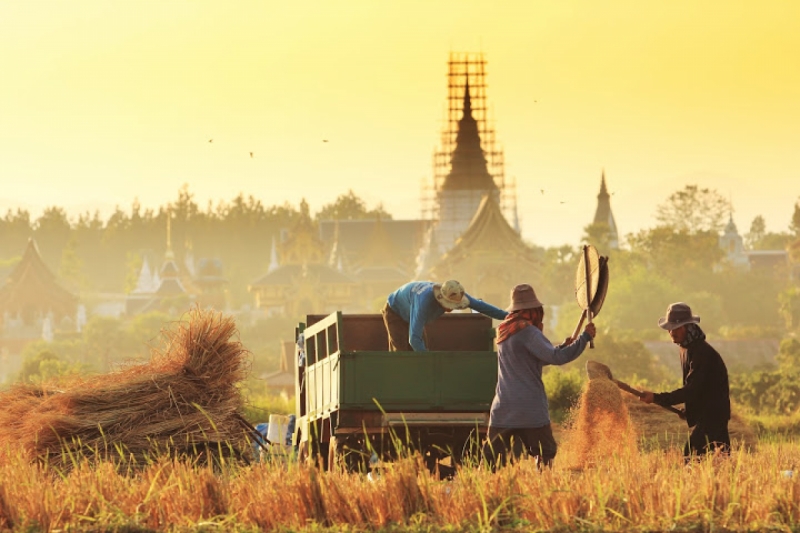




What should one do to help the other attain good health and conquer malnutrition?
The answer could be pretty simple – give them food. That is, if all you want to do is to feed them now.
But what if you want to feed them for the many years to come?
That is the difficult question. Let’s begin with giving them a decent livelihood. A decent job should provide one the means to purchase food, which would help them combat malnutrition and food insecurity.
But if everyone has access to food, we might experience food shortage.
That is also true. So apart from a decent livelihood, which enables one to have access to goods, we should also help increase food production. That way, we can make sure that there would be enough food for all.
But to increase food production is to also utilize much of our natural resources, thus resulting to environmental degradation. This would certainly pose threats to sustainability.
That’s correct. So an increase in livelihood and food production should be coupled with proper natural resource management, to make sure that not only are we providing food for today, but that we are also “feeding the future.”
And how do we make this happen?
Let us learn from an existing project, because this much is what Helping Address Rural Vulnerabilities and Ecosystem Stability (HARVEST) in Cambodia aims to achieve.
HARVEST in Cambodia
Cambodia HARVEST is a five-year integrated food security and climate change program supported by the American people through the United States Feed the Future and Global Climate Change initiatives. The program seeks to reduce poverty and malnutrition by diversifying and increasing food production and income for up to 100,000 rural Cambodian households.
Cambodia HARVEST develops sound, agricultural-focused solutions to poor productivity, postharvest losses, malnutrition, lack of market access, environmental degradation, and the effects of climate change on vulnerable rural populations and sectors, including women.
The project works in provinces around the Tonle Sap Lake, where there is a high percentage of poor and food insecure families. The program is currently working with over 94,000 clients in approximately 1,500 villages throughout Battambang, Kampong Thom, Pursat, and Siem Reap provinces.
Challenges and Opportunities for the Rural Poor in Cambodia
Mr. Tonh Mok, Development Assistance Specialist of the United States Agency for International Development (USAID) in Cambodia, explained that the rationale behind the design of the program was all about challenges and opportunities.
According to him, the challenges in Cambodia include: weak institutional development in the public and private sectors; a lack of modern agricultural production practices; and an anemic input supply and value-adding chain critical to increasing Cambodia’s competitiveness.
On the opportunity side, Cambodia has rich and diverse renewable resources, but they are threatened by the weak application of existing policies, increasing income inequalities, and the lack of reliable economic data to inform resource management and investment policies, especially for rural Cambodia. The Royal Government of Cambodia (RGC) put a lot of effort to address these challenges and threats, but there was a lack of a coherent action plan for guiding and informing a concerted effort by the host country.
To this end, HARVEST program was designed with the central focus of supporting Cambodia’s Millennium Development Goal targets, including the reduction of extreme poverty and hunger and ensuring environmental sustainability.
Improving Agriculture, Enhancing Lives
Under HARVEST is a plethora of initiatives aimed at improving the lives of the rural poor. These include the following:
- Introducing new technologies through demonstrations on “lead” farmers’ plots associated with supply chain development.
- Providing regular and continuous technical assistance for rice, horticulture and fish pond farmers in cooperation with local extension agents.
- Strengthening the value chains through improvements in production, processing, postharvest, market access, and agriculture inputs.
- Assisting low-input aquaculture households through better management techniques and harvesting practices, and community fisheries through institutional strengthening.
- Promoting improved livelihoods and food security among marginalized groups (youth, poor and women) through community awareness activities on health education and nutrition, and vocational training.
- Promoting community forestry and protected areas through community agro-forestry, tree nurseries, reforestation, and non-timber forest products.
- Working with RGC to identify key priorities and issues, and address key policy constraints.
These are just some of the activities HARVEST is continually implementing in Cambodia since it began in 2011.
On the Right Track
With these activities carefully planned, the HARVEST Cambodia team is proud to say they are right on target in terms of achieving their objectives. According to Mr. Mok, although they have not yet measured the progress of poverty reduction and stunting, they can see an abundance of other achievements.
For example, almost 110,000 households in 1,500 villages benefitted from the programs through trainings and assistance in agriculture development, agriculture business, nutrition, natural resources management and others. To date, the project’s beneficiaries have generated more than $24 million in sales; on average there is an increase of 270% in yield of horticulture, 50% of rice, and 146% of fish.
Furthermore, they have established micro-gardens, food security and saving groups at 11,400 rural households – many of them are extreme poor – allowing families who own little land to grow nutrient-rich vegetables, have better access to finance, and build better support systems. They have likewise strengthened the ability of provincial officials to provide extension services to farmers based on Cambodia HARVEST’s proven techniques.
They also trained almost every household in their target villages about nutrition through mobile kitchen activity. This has resulted in a decrease in the number of underweight children under 5 years old by an astounding 31%.
Finally, more than 51,000 people confirmed having increased benefits derived from sustainable natural resource management and conservation with assistance from this program. Almost 80,000 people, 60% of whom are women, have increased capacity to adapt to climate change. That means that they are better equipped with and are knowledgeable about in growing crops and alternative livelihoods that are resistant to climate variations.

“One particular issue or challenge we faced at the beginning was to engage extreme poor households in the program. The Feed the Future Initiative aims to target the poorest of the poor to reduce poverty and hunger. However, initially in Cambodia, the program was not able to engage a large number of people from this group because they did not have enough land to adopt the new agriculture technologies.”
This challenge, however, was immediately addressed come the second year of the project’s implementation.
“In Year two, the inclusion approach of the program was reviewed and adjusted to ensure participation of extreme poor by introducing food security and saving groups. By participating in the food security and savings groups, the extreme poor benefited by expanding their social safety net and were able to access micro-loans to expand their livelihood activities and have access to funds for emergencies. Through the groups, the target population was also trained on financial literacy to better manage their cash flow, nutrition, and home gardening so that they can grow food for household consumption. These activities helped improve their food security and nutrition. They were likewise able to interact and help each other in their groups,” said Mr. Mok.
Women in Rural Development
Apart from its multi-perspective approach in implementing its activities, perhaps what makes HARVEST different from other development initiatives is its special focus on women.
Mr. Mok said that climate change mitigation and food security projects have to be gender-sensitive because it will increase the effectiveness of the projects and ensure equal and equitable benefits to all. Based on Food and Agriculture Organization (FAO), a key driver of inequality is around biased and discriminating practices that discourage women’s access to land and other natural resources. FAO estimated that if men and women had same access to resources, there will be a 20 to 30% increase in yields and a significant reduction in global hunger.
However, this does not mean that women alone are the drivers in boosting the yields. Thus, gender should be comprehensively analyzed and incorporated in every design of climate change and food security programs. Inclusive programming is a key priority for USAID. In Cambodia, Mr. Mok explained that gender, youth and the extreme poor are considered in all project design.
Ways Forward
The project may be ending very soon in 2016, but the project still has a long way to go in terms of attaining sustainability and long-lasting impact.
With this, Mr. Mok recommends some ways on how future initiatives can support their already existing initiative so that positive impacts can truly be felt in the long run.
According to him, Cambodia is one of the food-insecure countries vulnerable to climate change. Majority of the population depends on agriculture, with only limited land plots for farming. Thus, every food security interventions should include climate change aspects and new or improved technologies that require less manpower, but are more productive. Nutrition (quality, not only quantity of food) should always be the niche of food security.
Furthermore, all climate change and food security interventions should carefully take into account social inclusion. They should be designed to capture and increase benefits to the most vulnerable groups.
Lastly, farmers should not be trained to produce only for subsistence purpose, but likewise help them cross over to the market.
This just proves that a single initiative can aim for sustainable, inclusive, and multi-sectoral development all at the same time. And as long as these kinds of projects with a true heart for the poor continue to flourish, poverty, food insecurity and climate change could, in the future, no longer be such a huge threat for the rural Cambodian people.